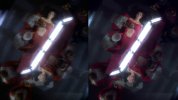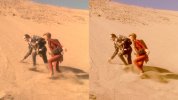It all depends on the quality of the work. But if Yes/No, then Yes.
Original elements need to be studied to check for re-use and cleaning. That's a whole conservation effort.
Digital assets need to be built for shot replacement and upgrades. There is no library of assets that is ready to go; the modeling and texturing done on the originals is mostly garbage.
Most of DS9 and relevant fx models are gone or destroyed. Many will need digital replacements if their film sources aren't usable.
FX need to be created and if replacing live action bg, hopefully that on-set camera movement data still exists, but it's doubtful.
Camera choices need to be ditched in favor of better shot design. A lot of sequences will need to be lengthened. Data still exists for spaceship porn shots etc, but it's a lot of bad framing and movement. Oh, '90s, you have a lot to answer for. Audio cue implications here too.
Folks who could have been great sources of insight and problem-solving are far less interested now, and more than a few are already gone. Whoever takes on supe positions has to be willing to put the time in to understand how things were solved, and translate. The project will also need multiple teams. And certain folks from the original work will need to be kept away from it.
This isn't a 2- year project like Paramount, in its idiocy, wanted it to be.
Okay, so let's assume that most of these things are garbage.
The Roddenberry Archive exists, and likely is rebuilding those digital assets, couldn't those be used?
They seem to be built for cinematic productions.
Also, why do sequences and shots need to be lengthened?
As for framing, what is the worst framed camera choice in the VFX that needs to be changed?
Like, if they were aiming for something between TNG:R and Babylon 5:R, couldn't they hit that without having to go to the trouble of complete shot recreation?
There are plenty of wide matte painting shots that in many cases could simply be upscaled, they don't contain live actors, and there are high res scans of those, if one chose to use them.
As for recompositing, most of it's blue screen, and there's a rich history of roto there.
So It looks like you have a handful of challenging shots with odo, many of those don't seem like they'd be hard to do now.
Hollywood has been able to do the T 1000 for nearly 30 years.
I'd think it would take two years to get the basic masters together, if it took two years to get X files completely scanned and conformed, then it would take two years to get the foundation ready.
The Conservation effort of 35mm elements shouldn't be that long. iConform would help.
That's the most important part of that.
The second team would be dealing with 35mm VFX assets. Model shots, etc.
Some of that content would come from archives from ILM, that were used on TNG:R, and the 4k film restorations.
The B team here would probably deal with viewscreens of actors, upscaling when necessary, Console animations, Matte Paintings and the like.
The third team would be dealing with particle effects, phasers, transporters, ETC.
The Fourth team would probably be CG and would interface with Roddenberry Archive, A team would probably be a mix of VFX supervisors of the original with assets, and new people, B team would be finishers under the supervision of the Okudas.
Five teams altogether?
If you were to do Voyager and DS9 together, 10 teams."
If "What We Left Behind" is any indication, the Wormhole asset either survived or upscaled very nicely, and from what I gather, the main challenge is probably going to be Odo, and likely space battles.
If you interfaced with the fans who make these models as a hobby and compensate them, then you would be able to put this together even faster.







